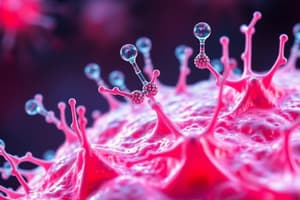Podcast
Questions and Answers
What is the approximate extracellular concentration of Ca2+ in mM?
What is the approximate extracellular concentration of Ca2+ in mM?
- 1 mM (correct)
- 0.1 mM
- 0.5 mM
- 10 mM
Which protein is not classified as a calcium binding protein?
Which protein is not classified as a calcium binding protein?
- Calmodulin
- S100 proteins
- Calsquestrin
- Protein kinase C (correct)
Which of the following is a mechanism for calcium influx into cells?
Which of the following is a mechanism for calcium influx into cells?
- Ca2+ ATPases
- Voltage-gated Ca2+ channels (correct)
- Calnexin
- Calmodulin
How many calcium binding sites does Calsquestrin have?
How many calcium binding sites does Calsquestrin have?
What type of ATPase is the Sarcoplasmic reticulum Ca2+ ATPase (SERCA)?
What type of ATPase is the Sarcoplasmic reticulum Ca2+ ATPase (SERCA)?
What distinguishes the Plasma membrane Ca2+ ATPase (PMCA) from SERCA?
What distinguishes the Plasma membrane Ca2+ ATPase (PMCA) from SERCA?
Which ion exchanger is involved in the removal of Ca2+ from cells?
Which ion exchanger is involved in the removal of Ca2+ from cells?
What is the primary role of calcium buffering proteins?
What is the primary role of calcium buffering proteins?
Which of the following is a characteristic of Ca2+-ATPases?
Which of the following is a characteristic of Ca2+-ATPases?
Which calcium transporter is primarily found in the endoplasmic or sarcoplasmic reticulum?
Which calcium transporter is primarily found in the endoplasmic or sarcoplasmic reticulum?
What role do Ca2+ -ATPases play in cellular function?
What role do Ca2+ -ATPases play in cellular function?
What is the function of sodium/calcium exchangers in cells?
What is the function of sodium/calcium exchangers in cells?
Which types of proteins can buffer free Ca2+ in cells?
Which types of proteins can buffer free Ca2+ in cells?
What is the primary effect of GPCR activation in calcium signalling?
What is the primary effect of GPCR activation in calcium signalling?
Which receptors are specifically associated with membrane calcium flow?
Which receptors are specifically associated with membrane calcium flow?
How does calcium contribute to neurotransmitter release?
How does calcium contribute to neurotransmitter release?
Which process is NOT directly influenced by intracellular calcium signaling?
Which process is NOT directly influenced by intracellular calcium signaling?
What is the primary function of PMCA in cellular calcium regulation?
What is the primary function of PMCA in cellular calcium regulation?
What physiological process requires calcium's role in synaptic plasticity?
What physiological process requires calcium's role in synaptic plasticity?
Which proteins regulate the activity of SERCA?
Which proteins regulate the activity of SERCA?
Which experimental finding highlighted the role of calcium in muscle function?
Which experimental finding highlighted the role of calcium in muscle function?
What ion ratio does the NCX exchanger maintain?
What ion ratio does the NCX exchanger maintain?
Which cellular function is primarily affected by calcium-dependent conductance?
Which cellular function is primarily affected by calcium-dependent conductance?
Which CA2+ channel subtypes correspond to the nervous system?
Which CA2+ channel subtypes correspond to the nervous system?
What is the primary role of the alpha1 subunit in voltage-gated Ca2+ channels?
What is the primary role of the alpha1 subunit in voltage-gated Ca2+ channels?
How does inositol 1,4,5-trisphosphate (IP3) facilitate Ca2+ release?
How does inositol 1,4,5-trisphosphate (IP3) facilitate Ca2+ release?
What determines the calcium affinity states of SERCA?
What determines the calcium affinity states of SERCA?
From which genes are the voltage-gated Ca2+ channels α1 subunits encoded?
From which genes are the voltage-gated Ca2+ channels α1 subunits encoded?
What is the effect of calmodulin on the PMCA activity?
What is the effect of calmodulin on the PMCA activity?
How many splice variants are produced by the ATP2B genes for PMCA?
How many splice variants are produced by the ATP2B genes for PMCA?
What is the primary function of STIM1 proteins in store-operated calcium entry (SOCE)?
What is the primary function of STIM1 proteins in store-operated calcium entry (SOCE)?
Which two proteins are primarily involved in store-operated calcium entry?
Which two proteins are primarily involved in store-operated calcium entry?
What occurs to STIM1 proteins upon calcium store-depletion?
What occurs to STIM1 proteins upon calcium store-depletion?
How does store-operated calcium entry affect cytosolic Ca2+ levels during prolonged cellular processes?
How does store-operated calcium entry affect cytosolic Ca2+ levels during prolonged cellular processes?
What is the role of calcium-binding proteins in the intracellular calcium homeostasis?
What is the role of calcium-binding proteins in the intracellular calcium homeostasis?
What is a characteristic of Ca2+ ATPases involved in calcium transport?
What is a characteristic of Ca2+ ATPases involved in calcium transport?
What mutation effect is associated with individuals who have gain-of-function mutations in STIM1?
What mutation effect is associated with individuals who have gain-of-function mutations in STIM1?
What types of channels are activated as a result of STIM1 translocation?
What types of channels are activated as a result of STIM1 translocation?
Which cellular organelle is primarily responsible for binding intracellular calcium?
Which cellular organelle is primarily responsible for binding intracellular calcium?
Flashcards
Calcium Homeostasis
Calcium Homeostasis
The process of maintaining a stable level of calcium ions (Ca2+) inside cells.
Ca2+-ATPases
Ca2+-ATPases
Proteins that pump calcium ions out of cells, maintaining low intracellular calcium.
Na+/Ca2+ Exchangers
Na+/Ca2+ Exchangers
Proteins that move sodium ions into and calcium ions out of cells.
Intracellular Calcium Buffering
Intracellular Calcium Buffering
Signup and view all the flashcards
Voltage-Gated Calcium Channels
Voltage-Gated Calcium Channels
Signup and view all the flashcards
IP3 and DAG
IP3 and DAG
Signup and view all the flashcards
STIM and Orai
STIM and Orai
Signup and view all the flashcards
Exocytosis
Exocytosis
Signup and view all the flashcards
Muscle Contraction
Muscle Contraction
Signup and view all the flashcards
Neurotransmission
Neurotransmission
Signup and view all the flashcards
Calcium Homeostasis
Calcium Homeostasis
Signup and view all the flashcards
Calcium Transporters
Calcium Transporters
Signup and view all the flashcards
Extracellular Ca2+
Extracellular Ca2+
Signup and view all the flashcards
Cytoplasmic Ca2+
Cytoplasmic Ca2+
Signup and view all the flashcards
Ca2+ ATPases
Ca2+ ATPases
Signup and view all the flashcards
Plasma Membrane Ca2+ ATPase (PMCA)
Plasma Membrane Ca2+ ATPase (PMCA)
Signup and view all the flashcards
Sarcoplasmic Reticulum Ca2+ ATPase (SERCA)
Sarcoplasmic Reticulum Ca2+ ATPase (SERCA)
Signup and view all the flashcards
Voltage-gated Ca2+ channels
Voltage-gated Ca2+ channels
Signup and view all the flashcards
Calcium Buffering Proteins
Calcium Buffering Proteins
Signup and view all the flashcards
EF-hand motif
EF-hand motif
Signup and view all the flashcards
PMCA
PMCA
Signup and view all the flashcards
SERCA
SERCA
Signup and view all the flashcards
NCX
NCX
Signup and view all the flashcards
VGCC
VGCC
Signup and view all the flashcards
IP3
IP3
Signup and view all the flashcards
Ca2+-ATPase
Ca2+-ATPase
Signup and view all the flashcards
Subunits of Voltage-gated Ca2+ channels
Subunits of Voltage-gated Ca2+ channels
Signup and view all the flashcards
L-type Ca2+ Channels
L-type Ca2+ Channels
Signup and view all the flashcards
Calcium concentration in E1 state
Calcium concentration in E1 state
Signup and view all the flashcards
Calcium concentration in E2 state
Calcium concentration in E2 state
Signup and view all the flashcards
IP3R structure
IP3R structure
Signup and view all the flashcards
SOCE
SOCE
Signup and view all the flashcards
STIM proteins
STIM proteins
Signup and view all the flashcards
Orai proteins
Orai proteins
Signup and view all the flashcards
STIM1 oligomerization
STIM1 oligomerization
Signup and view all the flashcards
Puncta formation
Puncta formation
Signup and view all the flashcards
Calcium ATPases
Calcium ATPases
Signup and view all the flashcards
ER calcium stores
ER calcium stores
Signup and view all the flashcards
Gain-of-function STIM1 mutations
Gain-of-function STIM1 mutations
Signup and view all the flashcards
Intracellular calcium homeostasis
Intracellular calcium homeostasis
Signup and view all the flashcards
Study Notes
Calcium Homeostasis - Part 2
- Calcium homeostasis is maintained both extracellularly and intracellularly
- Intracellular calcium is primarily bound by calcium-binding proteins or calcium-buffering proteins in the cytoplasm and organelles
- Calcium entry and exit from cells and organelles is facilitated by various proteins
Calcium Entry Mechanisms
- Ca2+-ATPases
- ATP2B (plasma membrane), ATP2A (endoplasmic/sarcoplasmic reticulum), ATP2C (golgi)
- Voltage-gated Ca2+ channels
- L-type calcium channels
- Na+/Ca2+ exchanger
- NCX1, NCX2 and NCX3
- Permeability transition pore
Calcium Binding Proteins
- EF-hand motif containing proteins
- Calmodulin
- S100 proteins
- Calcineurin
- C2-domain containing proteins
- Protein kinase C (PKC)
- Phospholipase-A (PLA)
- Phospholipase-C (PLC)
Calcium Buffering proteins
- Calnexin
- Endoplasmic reticulum
- 25 calcium binding sites
- Calsquestrin
- Sarcoplasmic reticulum
- 70 calcium binding sites
Inositol 1,4,5-trisphosphate (IP3)
- Ca2+ release from intracellular stores (e.g., endoplasmic reticulum) is triggered by IP3
- IP3 receptors (IP3R) are located on the membranes of intracellular stores
- IP3 receptors are 4 transmembrane spanning helices
Voltage-gated Ca2+ Channels (VGCC/VOC)
- The α subunit is the largest and contains the voltage-sensor, calcium-selective residues (e.g., glutamine)
- The β subunit, is intracellular
- The α2β subunit is extracellular (two proteins bound by disulfide bridges)
- These channels are encoded by the CACNA1 genes
- Three subfamilies
- L-type channels
- P/Q-type channels
- N-type channels
- R-type channels
- T-type channels
Store-Operated Calcium Entry (SOCE)
- Intracellular Ca2+ stores are limited.
- SOCE is a long-lasting influx mechanism triggered by store depletion
- It is involved to prolonged elevation of cytosolic Ca2+ (e.g. transcription)
- Two key proteins are involved: STIM1 and Orai
- SOCE involves STIM1 protein oligomerization and translocation to the ER/SR-PM (forming puncta), binding to the same Orai site, and channel activation which allows Ca2+ entry.
Ca2+-ATPases - PMCA
- PMCA, pumps 1 Ca2+ out of the cell for each ATP hydrolyzed.
- Activity can be increased by binding of calmodulin to the c-terminal domain.
- Encoded by 4 genes (ATP2B1-4) and results in 4 splice variants (PMCA1-4).
Ca2+-ATPases - SERCA
- SERCA pumps 2 Ca2+ into the sarcoplasmic reticulum.
- Activity can be regulated by ATP and phospholamban (PLN).
- Encoded by 3 genes (ATP2A1-3) with variants
NCX (Sodium/Calcium Exchanger)
- NCX belongs to the Ca2+, cation antiporter superfamily;
- This exchanger moves Ca2+ out and Na+ in or out from the cell depending on electrochemical gradients
- 3:1 Na+ and Ca2+ exchange is possible
Metabloites of Vitamin D and 25-Hydroxyvitamin D
- NCX belongs to the superfamily of Ca2+, cation antiporter
- Moves Ca2+ out of cells
- Activity of Na+ & Ca2+ exchanger can be changes based on calcium-binding domains (CBD)
- Encoded by the SLC8 gene and produces 3 isoforms (NCX1, NCX2 and NCX3) which are found in muscle and brain
Studying That Suits You
Use AI to generate personalized quizzes and flashcards to suit your learning preferences.



